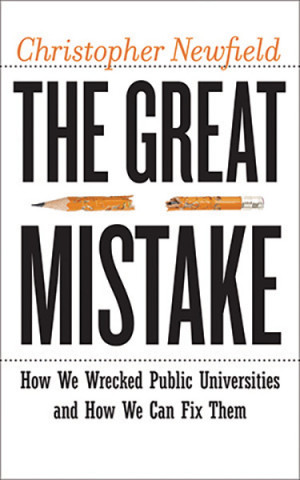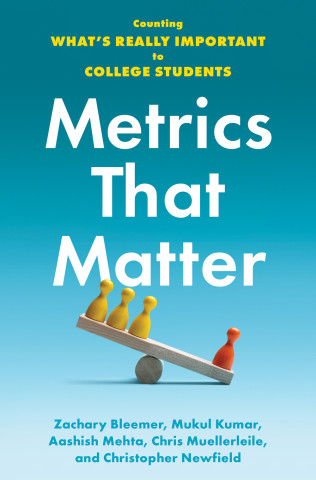I'm sure 2014 in higher ed was different from 2013, but right off I can't think of how. The nation continued its permanent public university austerity program, encouraged flimsy hopes for ed-tech rescues, conducted long political arguments over possible 2-percent revenue increases, fantasized about self-unbundling into flexi-modularity, and proclaimed indignant doubts about the educational value of going to college at all. So what was new? Even my biggest stayed the same, which I called the "hardening of the downward definition of public higher education through budgetary means, with no public debate."
Cheer up, I said to myself--it's the holidays! Santa Barbara's one day of winter rain has already come and gone. Some new things did happen in 2014 higher ed, and some of them were good.
1. The College Liberation Movement. The splashy version came from some Ivy League humanist dissidents who described elite private universities as sorting machines for those reared to rule our newly post-middle class society. There was the "excellent sheep" debate, started by William Deresiewicz's July article, "Don't Send Your Kid to the Ivy League" and carried on in his book, Excellent Sheep, sustained by attacks on him by Jim Sleeper among others, and brought in quieter form to the big screen by the film Ivory Tower.
Dr. Deresiewicz drew a sharp line between what happens at places like Yale, described as training in "the analytic and rhetorical skills that are necessary for success in business and the professions," and actually learning how to think. However one felt about the details, the discussion put the humanistic goal of personal development at the center of the college agenda. It cut against the naïve vocationalism that has justified corporate reach-ins to core educational functions. It clarified that colleges must do what businesses cannot do, according to their own vision and expertise.
I have my quarrels with this Ivy humanism, starting with my dislike for the overdrawn contrast between liberal and practical arts. I think that the systematic inculcation of deep skills are next on the to-do list of public universities. But higher ed leaders have so completely lost confidence in the special powers of higher learning that they needed every kind of explanation of why teaching is not a business.
2. A New Deal for Faculty Governance. When the chancellor of the University of Illinois at Urbana-Champaign announced that she was pocket vetoing the appointment of Steven Salaita to a professorship that had been approved by every campus agency, she awakened the closest thing to a national faculty outcry that the country had seen in years. Prof. Salaita remains in limbo, and governance procedures have not been fixed. But I don't know a single faculty member who isn't now aware of the fall of the faculty, having in 2014 seen faculty be overridden in a main area of authority. The premature MOOC contracting of 2013 showed admin to be as ready to redesign the curriculum as it is to make all financial decisions on its own. Many faculty who weren't worried about MOOC-mediated governance got worried about the suspension of hiring protocols by senior managers under donor pressure.
Other kinds of encroachments also got faculty attention. The newly-hatched Board of Trustees for the University of Oregon planned to write the faculty senate out of the university's new constitution, with the effect of "relegat[ing] university stakeholders to supplicants." Faculty generated an imposing counterattack. We learned all over again that faculty bodies, once awakened, have more than enough brains at their disposal to stop any train that "has already left the station."
3. Fixing Women's Student Experience. Even the federal government got involved with the question of what campuses are or aren't doing about sexual assault. It was impossible to ignore the issue of inadequate protection for victims while pondering Columbia student Emma Sulkowicz's "carry that weight" thesis project, in which she has carried a mattress with her everywhere on campus until her alleged assailant is no longer at Columbia. (Thank you Gawker for telling us that the alleged assailant is a feminist.) The Chronicle of Higher Education had a huge spread about "alcohol's hold on campus" ( as in "A River of Booze"), and what it lacked in news value (did you know that some college students drink too much??) it made up in expressing general worry that academics are getting lost in a labyrinth of peripheral activities. Concern about the welfare of women was strong enough to prompt coverage of a study showing that college women are raped less often than non-college women of the same age, which helped embed the campus problem in a wider national context. Rolling Stone's partial retraction of its "bombshell article" about a alleged gang rape at a University of Virginia frat house did not produce a chorus of triumphant claims that sexual assault is a phony problem. This year, colleges en masse started to confront women's continuing--if not escalating--physical and psychological insecurity, and the national coverage was a major reason.
4. Contingent Faculty Come in from the Cold. In early 2013 I wasn't picturing the adjunct faculty group New Faculty Majority appearing before Congress to describe academia's faculty labor problems, but it happened in November of that year, and the momentum carried into 2014. We're finally seeing proposed legislation requiring colleges to report on their use of part time and non-tenure track instructors. Adjunct faculty also won an case about their free speech rights and had their status considered in a student debt forgiveness proposal. They have in general, because of the work of Prof. Maisto and many others, become a major presence in discussions of the future of higher ed.
Writing in this space, Jennifer Ruth raised the issue of tenure-track faculty complicity in creating a disposable workforce, and named some necessary costs of reversing the trend. 2014 brought unprecedented public awareness of the overuse of contingent faculty and of the shame of their exploitation. This has already meant increased interest in tenure-track -- non-tenure track (NTT) alliances. This would improve NTT conditions and reduce the divisions within the faculty that have empowered administrations at faculty expense. Awareness of these possibilities is deeper than it was just a year ago.
5. The Rise of Educational Quality. In 2014, student debt hit the wall. The usual justifications of this destructive kludge of a funding strategy are yielding diminishing returns with students along with everyone else. Adding to the pressure, "the debt is too damn high" was joined by another theme, "debt for what"? Students at the UC Regents meeting in November were eloquent on the subject of the shrinking educational benefits of attending UC that they traced directly to budgetary "efficiencies" like giant lectures, mechanized grading, and near-zero rates of individual attention. "We want classes. We want professors," UC's student regent felt the need to explain to Governor Jerry Brown. State funding will stay flat without a big push, and detailing the sources and costs of quality education could give state governments their first concrete--and politically charged--reason to reverse years of funding cuts.
I never tire of pointing out that the only reason for the existence of public universities is mass quality--mass access to top quality teaching and cutting-edge research--that puts regular folks on the level where they can genuinely match elites. It's not too soon for faculty to join students in putting the quality back in mass quality, while creating news kinds of quality to reflect on current conditions. The success students had this year in holding off major politicians like Jerry Brown--and in getting cited in revenue arguments by governing boards--signaled to at least some faculty that it's time to step up.
6. Relinking Student Protests and Social Movements. The biggest recent domestic news has been the protests of the non-indictment of police officers who had killed unarmed Black men, particularly in the cases of Michael Brown in Ferguson, MO and Eric Garner in New York City. The "Hands Up Don't Shoot" and "I Can't Breathe" protests overlapped with various campus struggles about funding, tuition, debt, diversity, free speech, campus policing, the morale of students of color, and other issues. These intersecting protests linked the public university to the postwar period of its major development, when society could imagine colleges as offering knowledge for the satisfaction of broad social needs. In contrast to the narrower mission of serving technology industries, which now seems to many, as the middle classes stagnate, to be just one more way to enrich the rich, the classic social movements increased both the social influence of the university and the quality of its knowledge. 1950s and 1960s voters rewarded universities for this pertinence before conservative elites punished them for it. The university's golden age and the civil rights movement had different origins but symbiotic aspirations. This year, parallels among student and non-student movements pointed towards a better common destiny.
One thing about 2014 was the same as previous years. I loved the basics of the job-- the research, the teaching, and the learning with colleagues and students. My UCSB students were wonderful. They came through bouts of overpolicing, a mass murder, and ever-mounting levels of background stress; they wrote great crime stories in the detective fiction lecture I just finished, and had all sorts of ideas for educational upgrades that will continue next year.
In the meantime, many thanks from us for reading Remaking the University this year, and warm wishes for the rest of the holidays.
Flooding the Zone With Words
3 hours ago





3 comments:
Chris: You are traveling in a very narrow circle if you don't know a single faculty member who hasn't heard of Salaita. Ask a truly random sample of faculty - all schools, all departments - on your campus. In any event, there is an old legal saying that bad cases make bad law. By the way, anyone who has served on CAP at UCLA and I presume your campus knows of particular cases in which a top official has overridden faculty recommendations. Sometimes a promotion denied by a dept. is granted. Sometimes a promotion approved by a dept. is barred. It's rare but it happens. And, of course, there was Angela Davis, back in the day, and the loyalty oath affair even further back. -Dan Mitchell
@California Policy Issues
Hi Dan,
If you have been following the Salaita case your comparisons (with the possible exception of Angela Davis) aren't particularly apt. In the Salait case, there had been approval of the appointment throughout the normal spectrum of administrative oversight including what would be the equivalent at UC of the Academic Affairs VC. Moreover as you know when there is a disagreement between say CAP and a department or even a VC and a department there is a communication with the department to allow additional material or an appeal. The case here is more like an appointment that has gone through the department, the Dean, CAP, APO, and been approved by the VC only to have the Chancellor or the President decide not to send it to the Regents without consulting back with the appropriate academic people. I don't think that is what normally happens at UC or elsewhere.
Dan the only case I can think of on my campus of this kind of top-level reversal was of the Rudy Acuña appointment to Chicano Studies around 1993. And in that case admin had the backing of a faculty ad hoc committee which recommended rejection of a departmental decision, which was not unanimous as in Salaita's case but split evenly between yes and abstain. I'd be interested in UC cases as stark at Salaita's. happy holidays.
Join the Conversation
Note: Firefox is occasionally incompatible with our comments section. We apologize for the inconvenience.